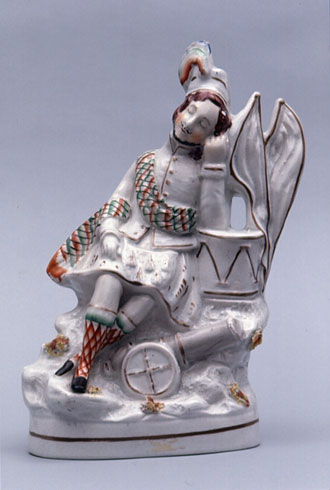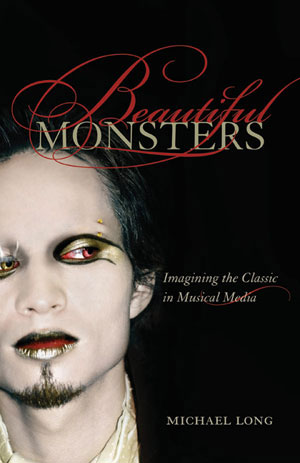
Beautiful Monsters explores how “classical music,” and the idea of “the classic” itself, found a home in the American popular imagination. Concerns about the apparent cultural demise of classical music at the turn of the twenty-first century, the subject of several recent books, provided a jumping-off point for my introduction. But Beautiful Monsters is intended as a selective history of twentieth-century music in general. It responds to the failure of academic and journalistic writers specializing in concert-hall music, film music, pop, rock, rap, disco, and other popular genres to cultivate much common ground. Orthodox writers, including the dogmatically hip ones, tend to hide the sounds of both old and new music in categorical boxes bearing labels of stylistic, institutional, political or sociological identity. I am concerned more with experience than categories, and argue that popular recordings and visual media have enriched music’s capacity to engage the individual imagination while underscoring the commonality of musical experience.
My project was triggered by a trivial coincidence. In the car, enjoying the easy companionship of a mixed-vintage pop radio station, I heard three huge and hugely familiar hits – rock “monsters” – played as a continuous set, and began in my mind to sort through the obvious and not-so-obvious relationships among them. In each, the traditional materials of rock music mingled with sounds drawn from the past (musical motives, instrumental color, lyrics, vocal phonemes), things encountered in undergraduate courses devoted to the appreciation of classical, i.e., historical music. (I’ve taught plenty of them.) But the amazing success and longevity of these rock warhorses could not be attributed entirely to antiquarianism. There are plenty of popular offerings full of clever citations and historical atmosphere that have fallen flat or faded quickly. These mega-hits had somehow managed to construct an expressive discourse that was unusual, yet immediately intelligible to a broad, sociologically diverse listening population. How best to explain the way such hybrid musical items work effectively? What could such an investigation tell us about how we experience and organize the scope of a stylistically unpredictable, mass-mediated aural world? I decided that a meaningful approach to writing about music in the twentieth century (at least the music most Americans had heard) might center on how components of the classics have come to serve as expressive options within the cultural vernacular.
“Popular recordings and visual media have enriched music’s capacity to engage the individual imagination while underscoring the commonality of musical experience.”
The book moves fluidly, even unexpectedly, among chronological periods, genres, types of media, and among ways in which the “classic” has been defined since the second century C.E. All of the chapters cover a lot of ground. I know of no other book that treats film music and pop recordings with the same degree of critical and historical depth. The point, not to mention the fun, lies in the details. Did the music played on Michael Jackson’s carousel reflect a classic philosophical position? What might Dante have said about surf music? What roles did Richard Wagner play in the scoring of Hollywood’s early sound films, the poetry of Allen Ginsberg, the recordings of Phil Spector, and the decline of King Crimson? Why did “Mr. Holland” write a symphony rather than a concerto? Whose music was more classical – DMX’s or Busta Rhymes’s? Investigating these eccentric and occasionally playful questions provides some insight into how we listen, why we find it important to listen in the first place, and how musical hearing is enlivened by the classic’s presence in the vernacular imagination.
Beautiful Monsters emphasizes the expressive capacity of so-called “mass” media and the receptive powers of so-called “mass” audiences. Of course that nameless and faceless congregation of individual listeners in fact rarely experiences musical media en masse. Modern listening is most often intimate, or even solitary, a detail that has not been emphasized in traditional “readings” of mainstream musical and film culture. Throughout my book, the imaginative listener intersects with descriptions of acoustical and visual spaces: stereoscopic photography, reverb, animation, special-effects shots. But imaginative hearing is also situated in the text within a mainstream of shared listening expectations. That mainstream, our cultural vernacular, is made up of special collections of gestures, sound fragments, and image types. Borrowing a term from linguistics, I refer to those collections as registers, one of which is the register of the musical classic.
This is as far as I take any significant analogy between language and music in the book. Grammar, syntax, and even “meaning” are less essential to me than the registral connotations of sounds. They are the most expressive components of both language and music. That argument isn’t mine – it’s Dante’s. I hope potential readers of a book on popular culture won’t be put off by my launching the first chapter with a brief summary of one of Dante’s more obscure works. I couldn’t help myself. All of my other published work is in the area of medieval European music and poetry. As a medievalist I try to make sense of the expressive codes imbedded in works that appear small, superficially redundant, and often dull. My background equipped me especially well for sparring in my text with pop-culture bashers who deride mainstream music’s repetitive simplicity and underdeveloped syntax.
By situating a wide range of elements in the realm of common usage, I can avoid inhospitable theoretical buzzwords like inversion, rupture, and pastiche. These appear throughout modern and especially postmodern writing about any art that appears to be both “a little high” and “a little low” (I borrow that formula from Freddie Mercury, who figures prominently in chapter 7). One of my goals has been to respect the acoustical or visual details of each of the items I discuss regardless of its cultural or commercial associations. I invite Victorian domestic art, psychedelic rock, and low-budget horror movies to participate in a lively conversation without their having to fear an ambush by the big old guns of cultural critique (kitsch, camp, sentiment, inauthenticity). In Beautiful Monsters, a Chopin piano prelude, a disco anthem, and a Staffordshire figurine are distinguished not by relative or absolute cultural value, but by the varieties of imaginative experience they might activate.
All of the chapters are sectional in structure, with section headers. Anyone not interested in following the threads of the big arguments through the whole book might still find it interesting to read in bits. In fact, to fans of classic pop music or films, I’d suggest starting with the index and doing a title search for favorites.
The bookstore browser should probably dip into chapter 1. While it lays out the conceptual foundation for the arguments revisited throughout the book, chapter 1 also contains a bunch of illustrative case studies (including Jan and Dean, T. S. Eliot, Michael Jackson, Barry Manilow, Billy Joel, Kiss, Max Steiner, and others). They range in length from a few sentences to a couple of pages. And they are, I hope, both enlightening and entertaining.
Readers interested in the history of film music might particularly appreciate the chapter on musical Yiddishkeit (chapter 3). It is the most extended historical argument in the book, and draws popular literature into the mix along with music and film.
A serious reader interested in the humanities in general would find chapter 5, on “the dimensions of nostalgia,” especially interesting. This favorite of mine uses examples drawn from a broad spectrum of visual and musical materials to grapple with how artists have, in a literal sense, constructed nostalgia. That word has enjoyed tremendous circulation among academic writers, from literary critics to film scholars, for whom its implications rarely extend beyond those associated with “sentimental recall.” Here I analyze visual items ranging from pre-Raphaelite art to the films of Tarkovsky, and music from Baroque chorales to eighteenth-century clavichord music to psychedelic rock. I argue that nostalgia can serve as a surprisingly concrete and useful concept to frame specific modes of visual and acoustical expression. I suggest that art and media from all historical periods have employed these “formal” elements of nostalgia.

“In Beautiful Monsters, a Chopin piano prelude, a disco anthem, and a Staffordshire figurine are distinguished not by relative or absolute cultural value, but by the varieties of imaginative experience they might activate.”
I hope Beautiful Monsters will be appreciated for what it is – an effort to provoke conversation rather than to promulgate unassailable arguments. I’d like to think that it could inspire others, especially students in the still-expanding fields of popular music and media history and criticism, to think and to write about how music works expressively in humane ways, even in the new digital environments. Whether or not my attempt to keep the tone light much of the time succeeds with all readers, I think it important to have made that effort. I’d say the same about what could be taken as my occasional “lapse” into sentiment. Both are gently but intentionally subversive.
I admit to finding our overspecialized and over-theorized humanistic academy, including the discipline of musicology, an unnecessarily grim place. (This was perfectly encapsulated for me in a recent blurb I read for a presentation at a humanities center, advertising the speaker’s theoretical plan to “render happiness complex and difficult.”)
For me, the sound of the European musical past in twentieth-century American media was neither primarily the marker of a fraught cultural confrontation with normative culture, nor commentary upon or denial of normative culture. Media let the classic transform our ways of being expressive while the classic’s original implications were transformed right back, ensuring its continued viability in some form. For the future of our post-historical world of all musics, that was surely a good thing.


Michael Long is an associate professor of music at the University at Buffalo (State University of New York). A recipient of the American Musicological Society’s Alfred Einstein award and the SUNY Chancellor’s award for excellence in teaching, his essays on fourteenth- and fifteenth-century music have appeared in numerous collections and journals, including the Journal of the American Musicological Society and Early Music History. He has also served as an associate editor for the Journal of Film Music. Recent conference presentations on Kenneth Anger’s Fireworks and on Brokeback Mountain are part of his current book project exploring music, ritual, and the choreographic impulse in cinema.